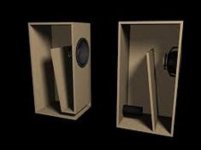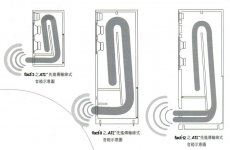What is the advantage of this acoustic design over the bass reflex?
If you refer to Castle design, it is a TQWT box with different aspect ratio compared to more usual squat TQWT box. Only advantage is that it is tall and narrow, what fits better in my living space so I took it as inspiration.
Another good design inspiration:
DTQWT-mkIII
Regarding TQWT vs bass reflex difference, I don’t find myself illuminated enough to offer good explanation. However, there is one explanation from Martin J. King (if you haven’t already, visit his site):
ML-TQWT vs Bass Reflex -
Techtalk Speaker Building, Audio, Video Discussion Forum
So, the TQWT can be seen as a backloaded horn with a bass reflex port at it's end or a special form of a transmission line which widens towards it's outlet but is suddenly constricted by an helmhotz resonator.
Usually, with TQWT you can get extended low frequency response while avoiding the boomy-ness, despite using high Qts driver. Downward firing horn mouth, with adjustable distance from the floor, provides some easy fine tuning, like having adjustable diameter/lenght tube in the bass reflex box.
That is TQWT box with two different port positions. What will any option give is impossible to say without putting them in some modeling application. Hardcore option is to build both and listen or measure. 
I am beginner in loudspeaker design so I should thread carefully with any advice. What I’m confident to say is that you could easily check by yourself with help of this page:
The Subwoofer DIY Page - Horn Folding
and
Hornresp
Install Hornsrep application, follow given instruction and tutorials, search diyaudio.com and read threads (it is fun and revealing). You should be able to get meaningful results from Hornsrepa after several days of learning.
I am beginner in loudspeaker design so I should thread carefully with any advice. What I’m confident to say is that you could easily check by yourself with help of this page:
The Subwoofer DIY Page - Horn Folding
and
Hornresp
Install Hornsrep application, follow given instruction and tutorials, search diyaudio.com and read threads (it is fun and revealing). You should be able to get meaningful results from Hornsrepa after several days of learning.
i run mine with a vintage Sony STR 6055 receiver. Replaced PX25 mono blocks. Haven't looked back. I've done the valve thing with front horns, 2A3, 300B, EL34, the only valve amp I have left is 6P3P in triode, but it's not in use.Ah, thanks for the explanation. I will have two 3.5" inch ports in the front that are 6" long. Ive tested with one port but I will now test with two.
Did I say I love these drivers? Even my wife loves them and they aren't even done. I can't imagine them sounding any less than what they do sound once I get a DAC and a tube amp. Right now I am running them with a $300 Sony STR590 receiver from best buy.
Very nice. Eventually I will use my stereo for playing surround sound with my TV. As for my speakers that I built, I will use a DAC and and a tube amp.i run mine with a vintage Sony STR 6055 receiver. Replaced PX25 mono blocks. Haven't looked back. I've done the valve thing with front horns, 2A3, 300B, EL34, the only valve amp I have left is 6P3P in triode, but it's not in use.
What kind of vacuum tube is 6P3P? Of the Soviet ones, is there either 6P3S or 6R3S or is it Chinese?i run mine with a vintage Sony STR 6055 receiver. Replaced PX25 mono blocks. Haven't looked back. I've done the valve thing with front horns, 2A3, 300B, EL34, the only valve amp I have left is 6P3P in triode, but it's not in use.
I don't know, sorry for the late and useless replyWhat kind of vacuum tube is 6P3P? Of the Soviet ones, is there either 6P3S or 6R3S or is it Chinese?
- Status
- This old topic is closed. If you want to reopen this topic, contact a moderator using the "Report Post" button.
- Home
- Loudspeakers
- Full Range
- New 10'' FR driver found

